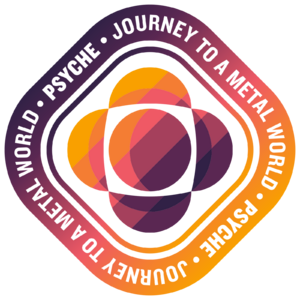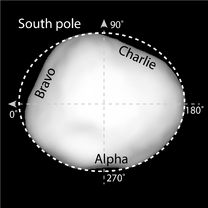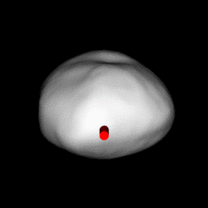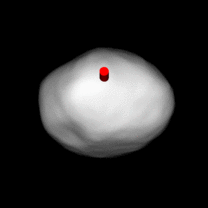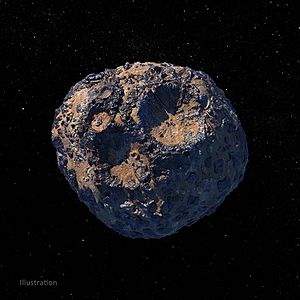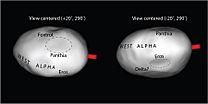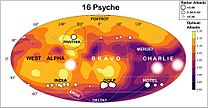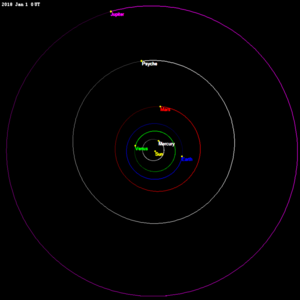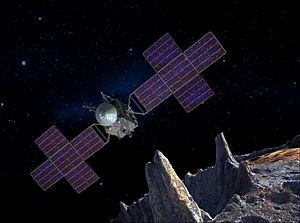16 Psyche facts for kids
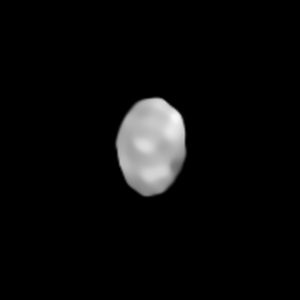
16 Psyche imaged by the Very Large Telescope's adaptive optics system in August 2019
|
|
| Discovery | |
|---|---|
| Discovered by | Annibale de Gasparis |
| Discovery site | Naples Observatory |
| Discovery date | 17 March 1852 |
| Designations | |
| MPC designation | (16) Psyche |
| Pronunciation | /ˈsaɪkiː/ |
|
Named after
|
Psyche (Ψυχή) |
| Main belt | |
| Adjectives | Psychean (/saɪˈkiːən/) |
| Orbital characteristics | |
| Epoch 13 September 2023 (JD 2460200.5) |
|
| Aphelion | 3.32 AU (497 million km) |
| Perihelion | 2.53 AU (378 million km) |
| 2.92 AU (437 million km) | |
| Eccentricity | 0.1342 |
| 4.999 yr (1825.95 d) | |
| 243.16° | |
| Inclination | 3.096° |
| 150.03° | |
| 27 April 2025 | |
| 229.41° | |
| Earth MOID | 1.53 AU (229 million km) |
| Physical characteristics | |
| Dimensions | (278±5 × 232±6 × 164±4) km 277 km × 238 km × 168 km 279 × 232 × 189 km (±10%) (278+4 −8 × 238+4 −6 × 171+1 −5) km |
|
Mean diameter
|
223±3 km 222±4 km 222+1 −4 km |
| Flattening | 0.41 |
| Volume | 5.75×106 km3 (best fit) |
| Mass | (2.29±0.14)×1019 kg |
|
Mean density
|
3.977±0.253 g/cm3 |
| ~0.144 m/s2 | |
| ~180 m/s (~600 ft/s) | |
| 4.195948±0.000001 h | |
| Albedo | 0.15±0.03 0.34±0.08 (radar) |
|
Spectral type
|
Tholen = M SMASS = X Bus-DeMeo = Xk |
| 9.22 to 12.19 | |
| 6.21 | |
16 Psyche (pronounced SY-kee) is a very large asteroid. It is mostly made of metal, which makes it special. An Italian astronomer named Annibale de Gasparis discovered it on March 17, 1852. He named it after Psyche, a goddess from Greek mythology.
The number "16" means it was the sixteenth minor planet ever found. Psyche is the biggest and heaviest of the asteroids made of metal. It is also one of the dozen heaviest asteroids known. It measures about 220 kilometers (137 miles) across. This asteroid holds about one percent of all the mass in the entire asteroid belt. Scientists once thought it might be the exposed core of a protoplanet (a baby planet). However, newer observations suggest this might not be true.
NASA sent a spacecraft, also named Psyche, to explore this unique asteroid. The spacecraft launched on October 13, 2023. It is the first time a human-made object is traveling to a metallic asteroid. The spacecraft is expected to arrive in 2029.
Contents
What is the Symbol for 16 Psyche?
Early astronomers created special symbols for the first asteroids they found. These symbols were like small pictures. Psyche was given a symbol that looked like a butterfly's wing with a star on top. The butterfly was a Greek symbol for the soul, and "psyche" means both "butterfly" and "soul" in Greek. This symbol might have inspired the design for the NASA Psyche mission's official logo.
However, remembering all these different symbols became too hard as more asteroids were discovered. So, in 1851, a German astronomer suggested using a circled number instead. This new way of naming asteroids started with 16 Psyche.
What are the Characteristics of 16 Psyche?
How Big is 16 Psyche?
Scientists have used different ways to figure out Psyche's size. One of the first estimates came from looking at the heat it gives off. This method suggested it was about 253 kilometers (157 miles) wide.
More recently, scientists have watched Psyche pass in front of stars. This event is called an occultation. By measuring how long the star is hidden, they can learn about Psyche's shape and size. Combining this data with other observations, they now agree that Psyche's average diameter is about 222 kilometers (138 miles).

How Heavy is 16 Psyche and How Dense is it?
Psyche is so massive that its gravity actually pulls on other asteroids. By studying these small tugs, scientists can calculate Psyche's mass. The most recent calculations show its mass is about 2.287 followed by 19 zeros kilograms.
Knowing its mass and size, scientists can figure out its density. Psyche's density is about 3.977 grams per cubic centimeter. This is much higher than most other small objects in our Solar System. This high density suggests it contains a lot of heavy materials, like metals.
What is 16 Psyche's Shape and How Does it Spin?
Scientists have created 3D models of Psyche's shape. They use information from how its brightness changes as it spins. They also use images from powerful telescopes and radar observations. These models show that Psyche is not perfectly round. It's shaped more like a squashed sphere, similar to a potato. Its dimensions are roughly 278 km by 238 km by 171 km.
Psyche spins around once every 4.19 hours. Its spin axis is tilted quite a bit, about 98 degrees. This means it spins almost on its side compared to its orbit around the Sun.
What Features are on 16 Psyche's Surface?
Scientists have found several interesting features on Psyche. Some areas are like large dips or valleys. These are similar to the huge basin on the asteroid 4 Vesta.
There are also several possible craters. Two large craters, about 90 km (56 miles) across, were named Meroe and Panthia. These names come from a Roman story. Other craters have been suggested near its poles and middle areas. Scientists are still working to confirm all these features.
Psyche's surface also has areas that are brighter or darker than average. The Panthia crater, for example, seems to be much brighter. The Meroe crater appears to be darker.
Radar observations show that some parts of Psyche's surface reflect radar signals very strongly. This suggests these areas have a high concentration of metal. Interestingly, some of these metal-rich areas are also optically bright. This might mean there's a connection between how bright a spot looks and how much metal it contains.
What is 16 Psyche Made Of?
Psyche's high density tells us a lot about what it's made of. If it were pure iron-nickel, like some iron meteorites, it would have to be very porous (full of holes). This is unlikely for an object its size.
Scientists think Psyche is a mix of metal and rocky materials. Some types of meteorites, like mesosiderites, have a similar mix and density. These meteorites are made of both metal and silicates (rocky minerals).
Observations have also found signs of silicate minerals on Psyche's surface. There's even evidence of water-related molecules, called hydroxyl ions. Since Psyche likely formed in dry conditions, this water might have come from smaller, icy asteroids that crashed into it.
How Did 16 Psyche Form?
Scientists have a few ideas about how Psyche came to be.
- Exposed Core Idea: One idea was that Psyche is the leftover metallic core of a much larger early planet. This bigger planet might have lost its outer layers in a giant collision. However, recent studies of Psyche's mass and density make this idea less likely.
- Re-formed Object Idea: Another idea is that Psyche was once broken apart by a huge impact. Then, its pieces came back together due to gravity, forming a mix of metal and rock.
- Iron Volcanism Idea: A third idea suggests Psyche might have been a differentiated object, like the dwarf planet Ceres. But instead of rock volcanoes, it might have had "iron volcanoes" (ferrovolcanism) while it was still cooling. This would mean metal would be concentrated in certain areas. Recent radar observations support this idea.
Exploring 16 Psyche
No spacecraft had visited Psyche until recently. However, NASA launched a mission to Psyche on October 13, 2023. This mission uses a robotic orbiter, also named Psyche. The team behind the mission, led by Lindy Elkins-Tanton, believes Psyche is very important to study. It is the only known asteroid that seems to be mostly a metallic core.
The Psyche spacecraft will orbit the asteroid for 20 months. It will study Psyche's surface, gravity, magnetism, and other features. The mission uses existing technology to keep costs down. The Psyche mission was chosen by NASA in 2017. After some changes to the launch schedule, it successfully launched in 2023. It is expected to reach the asteroid in 2029.
Psyche's closest approach to Earth happened on August 6, 2024. At that time, it was about 1.7 AU (254 million kilometers or 158 million miles) away.
See also
 In Spanish: (16) Psique para niños
In Spanish: (16) Psique para niños
- List of minor planets and comets visited by spacecraft
- List of missions to minor planets
- Asteroid mining


